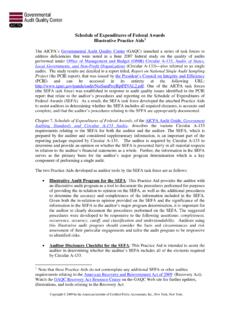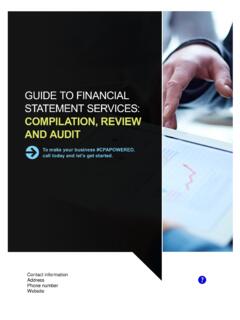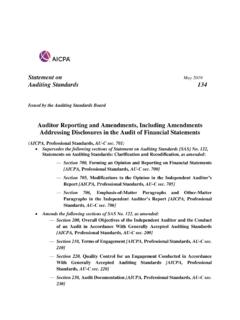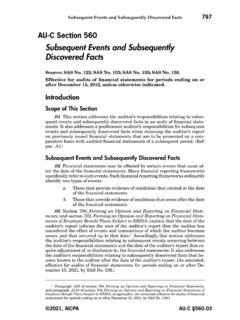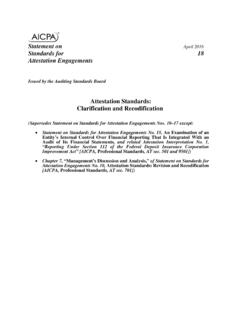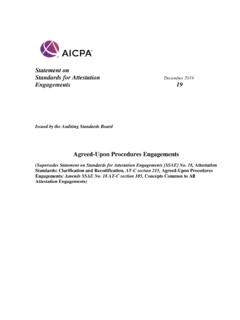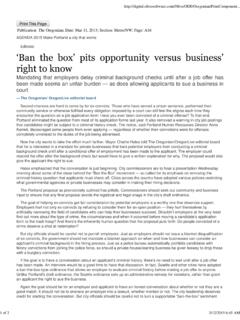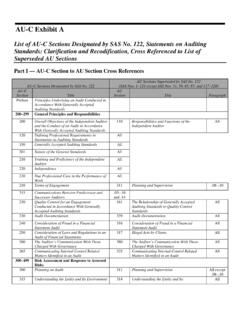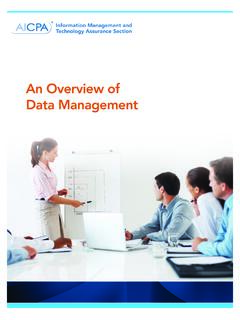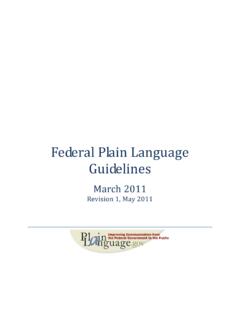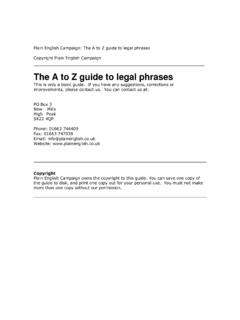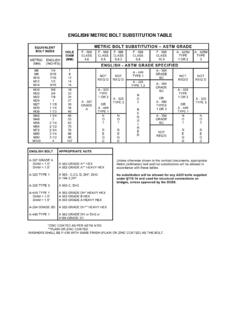Transcription of Center for Plain English Accounting
1 Employee Retention Credit (ERC) Financial Reporting & Disclosure Examples By: Robert Durak The Employee Retention Credit (ERC) was established by the Coronavirus Aid, Relief, and Economic Security (CARES) Act, 116-136, in March 2020. It was intended to help businesses retain their workforces and avoid layoffs during the coronavirus pandemic. It provides a per employee credit to eligible businesses based on a percentage of qualified wages and health insurance benefits paid to employees. It works as a refundable payroll tax credit claimed quarterly, and it can provide reductions to payroll taxes or cash refunds.
2 The ERC is available to both for-profit and not-for-profit (NFP) entities, but not every business is eligible. Two critical tests for eligibility exist a partial or total government-ordered shutdown, or a decline in gross receipts. The decline in gross receipts test is based on a "significant" decline in gross receipts in quarters of 2020 (more than 50%) and 2021 (more than 20%) compared with the same quarters in 2019. The CARES Act did not allow businesses that received Paycheck Protection Program (PPP) loans to also claim the ERC, but the Consolidated Appropriations Act, 2021, 116-260, which was enacted at the end of 2020, retroactively removed the limitation so entities that had applied for or received PPP loans could still get the ERC.
3 The American Rescue Plan Act, 117-2, provided that the ERC would go through December 31, 2021; however, the ERC was terminated a quarter early by the enactment of the Infrastructure Investment and Jobs Act, 117-58, at the end of the third calendar quarter of 2021 (for entities other than recovery startup businesses under Sec. 3134(c)(2)). This report addresses the financial reporting considerations related to the ERC. An appendix presents ERC disclosure excerpts. For information about ERC rules, eligibility, filing payroll tax returns, and other non-financial reporting issues related to ERC, visit the AICPA s employee retention credit guidance and resources webpage.
4 Report December 22, 2021 Center for Plain English Accounting AICPA s National A&A Resource Center Applicable Generally Accepted Accounting Principles ( GAAP) The ERC is a refundable credit. The CPEA does not believe that claiming the ERC is an income tax position within the jurisdiction of FASB Accounting Standards Codification (FASB ASC) 740, Income Taxes, as it applies to entities that do and do not pay federal income tax at the entity level, is not based on income, and the primary method of claiming the credit is on federal payroll tax forms. Many entities consider the ERC a type of government assistance or grant.
5 The CPEA believes that Accounting for ERC depends on whether an entity is a for-profit or NFP entity. For-profit entities can analogize to the guidance in either: FASB ASC 958-605, Not-for-Profit Entities: Revenue Recognition International Accounting Standard (IAS) 20, Accounting for Government Grants and Disclosure of Government Assistance FASB ASC 450-30, Contingencies: Gain Contingencies NFP entities account for government grants under GAAP in accordance with FASB ASC 958-605. As such, the IAS 20 model and the FASB ASC 450-30 model do not apply to NFP entities. Practice Note: Many entities applied FASB ASC 958-605 or IAS 20 when Accounting for PPP loans.
6 As such, those entities will be familiar with the Accounting models applicable to the ERC. Another Accounting model many entities used to account for PPP loans was the debt model in FASB ASC 470, Debt. The debt model is not applicable to the ERC because the ERC is a refundable payroll tax credit and not a loan. Retroactive Application of the ERC to 2020 The CPEA believes that the Accounting for retroactively applying the ERC to 2020 involves different Accounting compared to prospective Accounting of the ERC. We believe that the recovery of amounts previously paid and expensed to an employee is best analogized a loss recovery.
7 Prevailing practice in financial reporting for a loss recovery is to use guidance in FASB ASC 410, Asset Retirement and Environmental Obligations, specifically FASB ASC 410-30-35-8, which indicates that a claim for recovery should be recognized only when the claim is probable as it is defined in FASB ASC 450, Contingencies, more specifically in FASB ASC 450-20-25-1. Accordingly, if an entity feels that it is probable that it is entitled to recover amounts previously paid in 2020 via the ERC, then the entity should recognize a receivable for amounts to be received for the amounts paid in 2020 to be recovered via the ERC.
8 Any uncertainties related to qualifying for the ERC should be assessed as to whether the claim for the credit is probable. As for income statement presentation, we believe that either classifying the amounts as a reduction to payroll tax expense or as other income would be acceptable with appropriate disclosure of the election made by management. Our review of recent public entity filings indicates that more public entities are crediting the associated expense rather than recognizing the amounts on a separate line item. Practice Note: FASB ASC 410-30-25 addresses environmental obligations and subsequent recoveries.
9 However, given the lack of explicit guidance in the FASB ASC regarding other loss recoveries, FASB 410-30-25 is widely utilized for other types of loss recoveries by analogy. Prospective Accounting for the ERC - Applying the FASB ASC 958-605 Model Entities applying the FASB ASC 958-605 model would consider the ERC as a nonexchange transaction that is accounted for as a conditional contribution. This is based on the guidance in FASB ASC 958-605-25-5A, which indicates that a conditional contribution must have both: One or more barriers that must be overcome before a recipient is entitled to the assets transferred or promised A right of return to the contributor for assets transferred (or for a reduction, settlement, or cancellation of liabilities) or a right of release of the promisor from its obligation to transfer assets (or reduce, settle, or cancel liabilities) Given the eligibility requirements connected to the ERC, barriers and a right of return exist.
10 Barriers (or conditions) could include the various eligibility requirements such as meeting the rules for a decline in gross receipts and incurring qualifying expenses (payroll costs). Conditions (barriers) should be substantially met (overcome) by the entity before the ERC is recognized (see FASB ASC 958-605-25-11). Therefore, a refund receivable and income would be recognized in the period the entity determines the conditions have been substantially met. In cases where conditions are met over time or in stages, the ERC should be recognized as the qualifying expenses (payroll costs) are incurred, and other conditions ( , eligibility) are met.
